Fort Worth had some beautiful public buildings at the turn of the twentieth century, and if you and I had been teenagers in 1900, this probably would have been our high school:
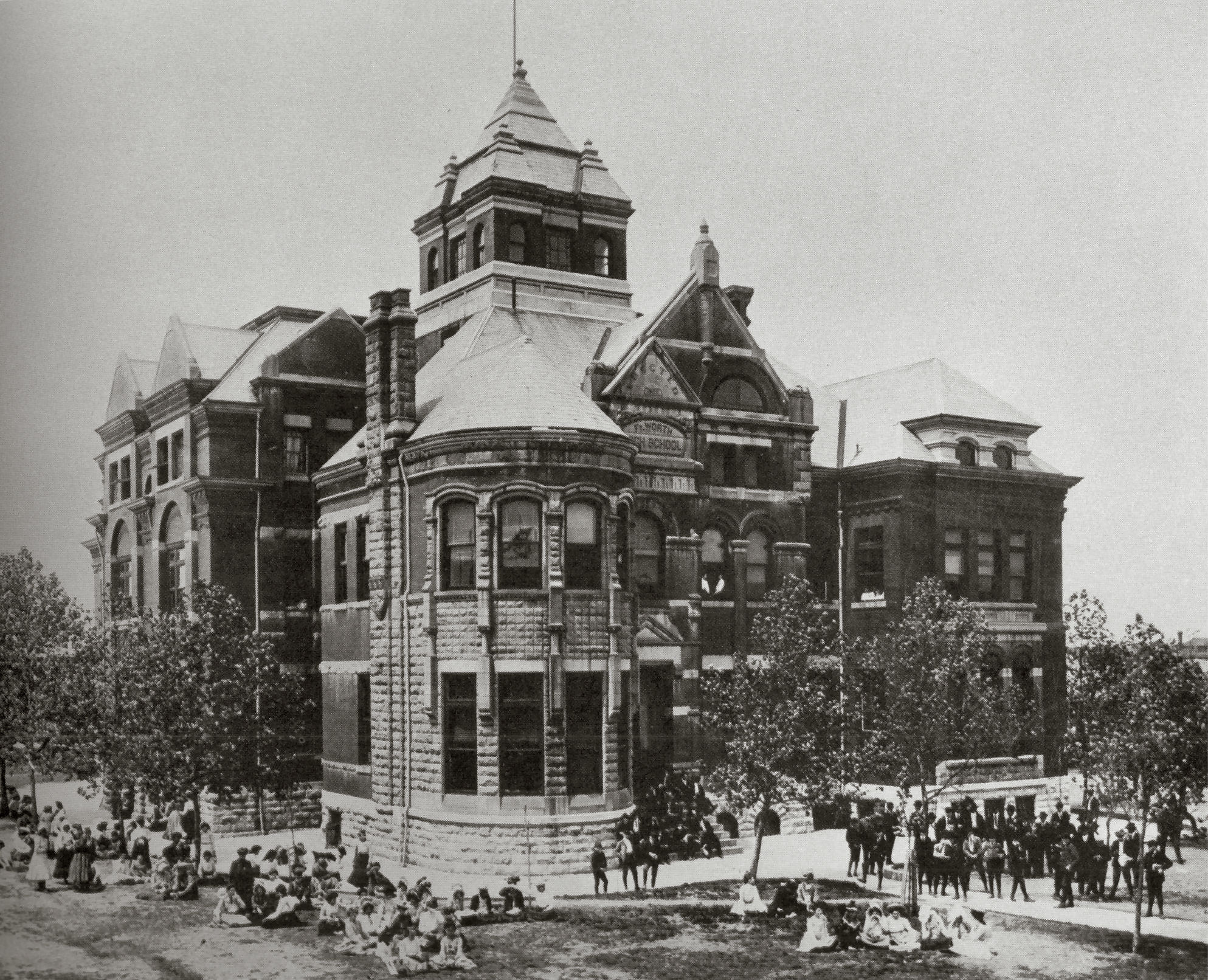 The Fort Worth High School building was a veritable castle of education. The school, located at 200 South Jennings Avenue between Jarvis and Daggett streets south of downtown, was designed by architects Sanguinet and Haggart and cost $75,000 ($1.9 million today) to build. The building also contained the office of the school board. (Photo from University of Texas at Arlington Libraries.)
The Fort Worth High School building was a veritable castle of education. The school, located at 200 South Jennings Avenue between Jarvis and Daggett streets south of downtown, was designed by architects Sanguinet and Haggart and cost $75,000 ($1.9 million today) to build. The building also contained the office of the school board. (Photo from University of Texas at Arlington Libraries.)
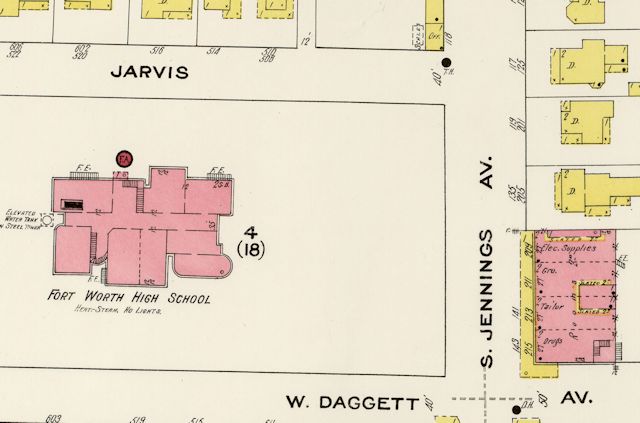 The school was located across Jennings Avenue from the Bicocchi Building (lower right).
The school was located across Jennings Avenue from the Bicocchi Building (lower right).
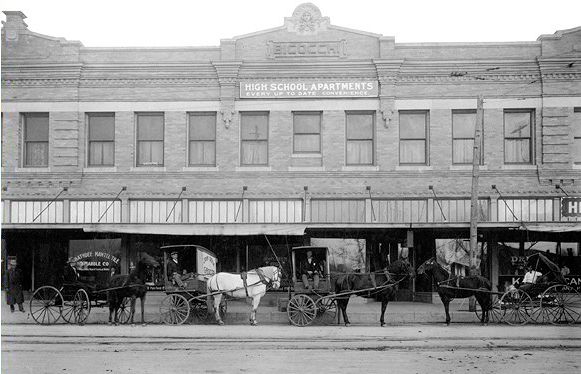 In fact, students could rent apartments in the Bicocchi Building. (Photo courtesy of Pointwise, Inc.)
In fact, students could rent apartments in the Bicocchi Building. (Photo courtesy of Pointwise, Inc.)
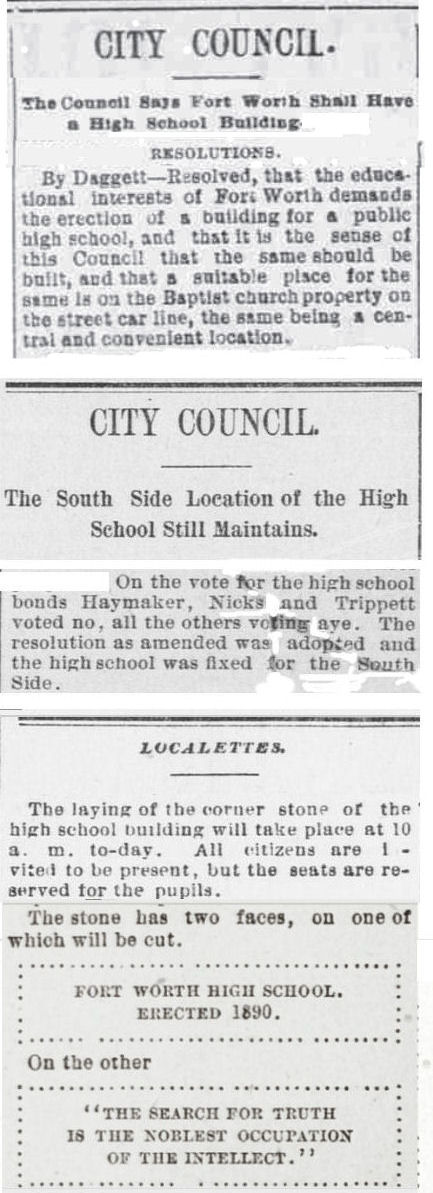 In 1888 city alderman Ephraim Beck Daggett had resolved that the time had come for Fort Worth to build a coeducational high school building (boys and girls had attended separate schools downtown). In 1889 the near South Side location was chosen. On March 28, 1890 the cornerstone was laid. (Five days later Daggett resigned from the city council.) The building was completed in early 1891. Until 1899 the building had no lunchroom, so girls in the domestic science classes made and sold sandwiches and soup.
In 1888 city alderman Ephraim Beck Daggett had resolved that the time had come for Fort Worth to build a coeducational high school building (boys and girls had attended separate schools downtown). In 1889 the near South Side location was chosen. On March 28, 1890 the cornerstone was laid. (Five days later Daggett resigned from the city council.) The building was completed in early 1891. Until 1899 the building had no lunchroom, so girls in the domestic science classes made and sold sandwiches and soup.
Fort Worth public schools had only eleven grades at the time.
 This was the faculty of the school in 1900 (photo from University of Texas at Arlington Library). The school mascot, not surprisingly, was the panther. The school colors were purple and white. Today’s Paschal High School traces its lineage back even further: to the first graduating class of the boys high school in 1885.
This was the faculty of the school in 1900 (photo from University of Texas at Arlington Library). The school mascot, not surprisingly, was the panther. The school colors were purple and white. Today’s Paschal High School traces its lineage back even further: to the first graduating class of the boys high school in 1885.
 In 1901 at the Opera House the school graduated thirty-five students, including Robert McCart Jr., Joseph Hogsett, Mary Beal Oxsheer, Margaret Berney, and Kate Stripling.
In 1901 at the Opera House the school graduated thirty-five students, including Robert McCart Jr., Joseph Hogsett, Mary Beal Oxsheer, Margaret Berney, and Kate Stripling.
 Fast-forward nine years. In early 1910 Fort Worth school trustee Edward Perryman Maddox called the high school building, then only nineteen years old, a “veritable fire trap.” The city was already planning to build a replacement high school and to use the first high school for overflow from the ward schools.
Fast-forward nine years. In early 1910 Fort Worth school trustee Edward Perryman Maddox called the high school building, then only nineteen years old, a “veritable fire trap.” The city was already planning to build a replacement high school and to use the first high school for overflow from the ward schools.
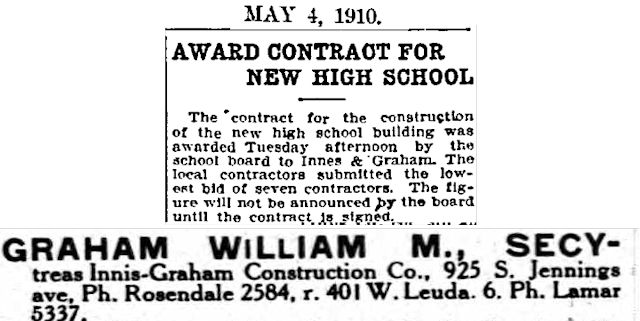
In May 1910 the contract for construction of the new high school was given to Innes-Graham Construction Company. 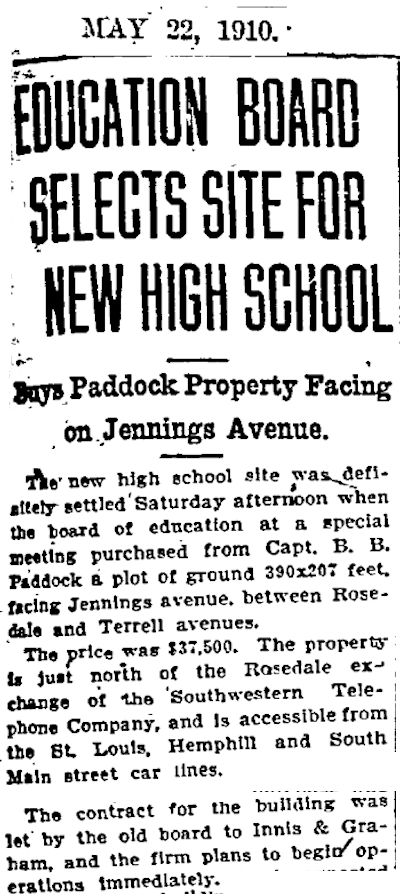 B. B. Paddock sold the school board part of his homestead at Jennings and Terrell streets.
B. B. Paddock sold the school board part of his homestead at Jennings and Terrell streets.
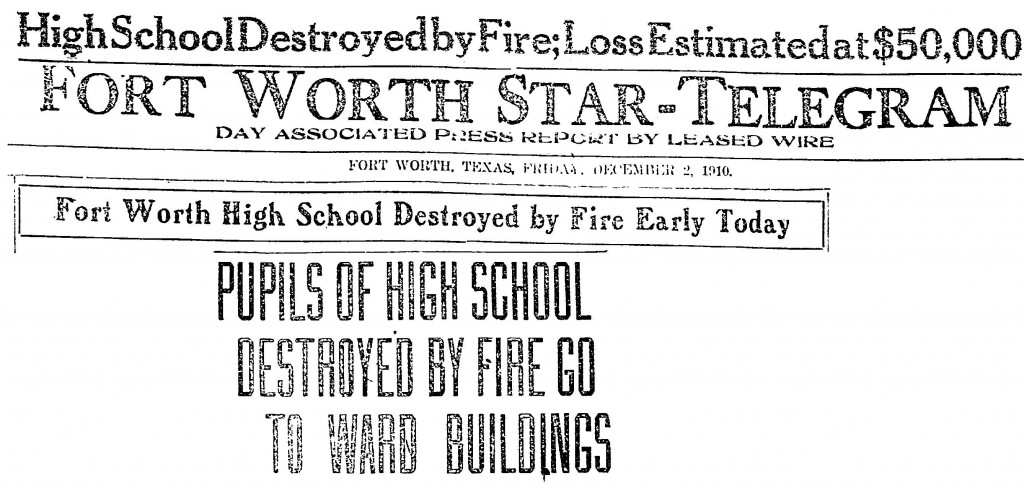 The fear of school trustee Maddox was well-founded. On December 2, 1910—110 years ago today—the first Fort Worth High School building burned.
The fear of school trustee Maddox was well-founded. On December 2, 1910—110 years ago today—the first Fort Worth High School building burned.
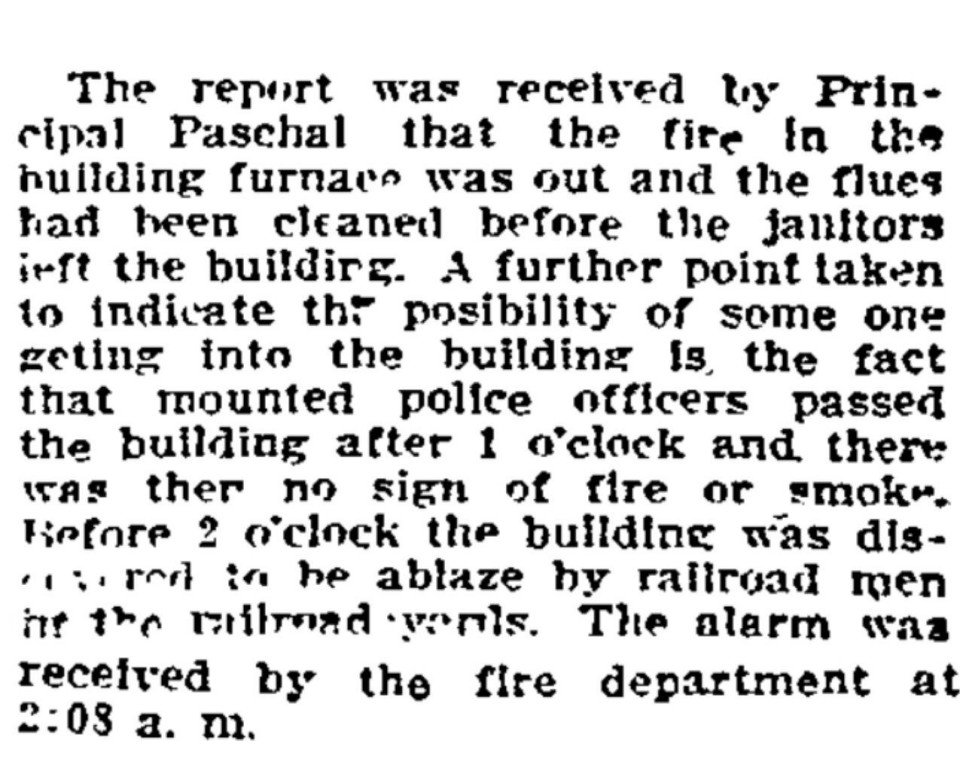
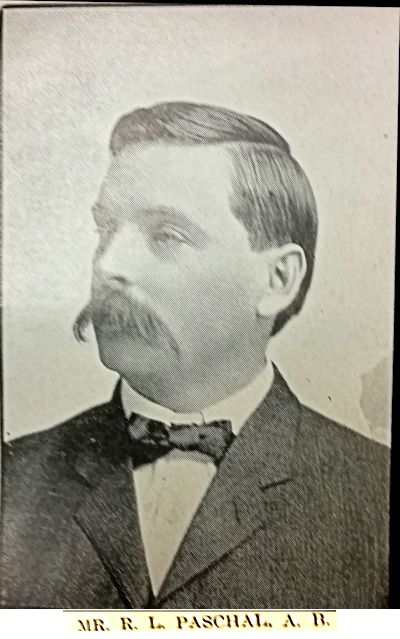 Robert Lee Paschal (1869-1958) had been principal of the school since 1906. The cause of the fire was never determined. The school’s 633 students were transferred to other schools and lost only one day of class. (Photo from 1910 Panther yearbook.)
Robert Lee Paschal (1869-1958) had been principal of the school since 1906. The cause of the fire was never determined. The school’s 633 students were transferred to other schools and lost only one day of class. (Photo from 1910 Panther yearbook.)
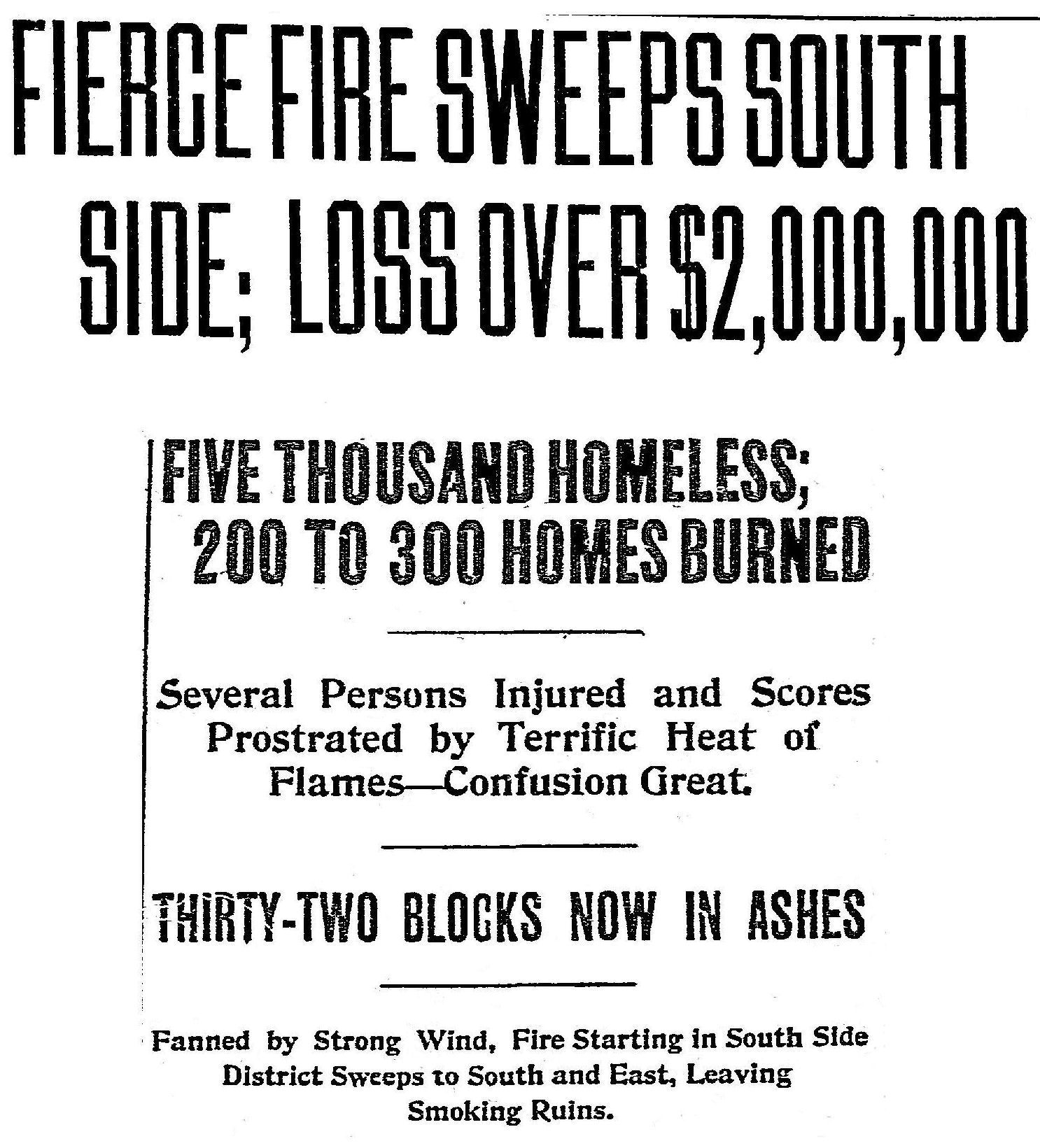
Footnote: Seven of Fort Worth’s early fires (four of them on railroad property) occurred in the area between Lancaster Avenue and Hattie Street south of downtown: Spring Palace (1890), 1882 T&P passenger depot (1896), 1899 T&P passenger depot (1904), Fifth Ward school and Missouri Avenue Methodist Church (1904), 1902 T&P freight depot (1908), South Side (1909), Fort Worth High School (1910). The South Side fire of 1909 had spared the high school building even as three churches located within two blocks of the school (Broadway Baptist, Broadway Presbyterian, and Swedish Methodist Episcopal) were destroyed.
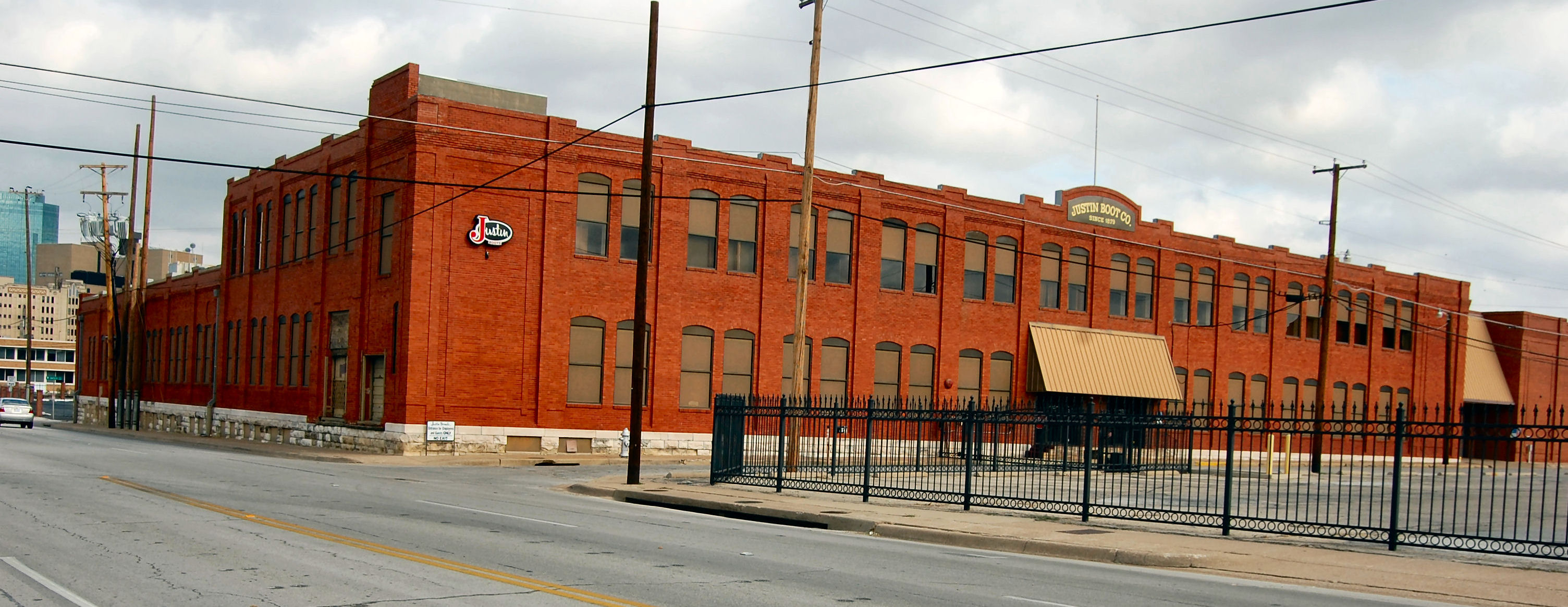
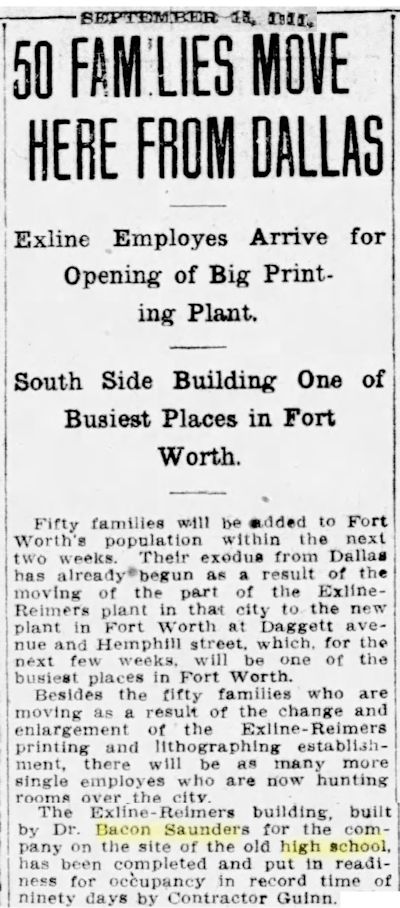 In 1911 the big building that today houses the Justin boot company was built on the site of the high school by Dr. Bacon Saunders. The building originally housed the Exline-Reimers printing plant.
In 1911 the big building that today houses the Justin boot company was built on the site of the high school by Dr. Bacon Saunders. The building originally housed the Exline-Reimers printing plant.
 In 1911 the replacement school, Central High School, opened a few blocks south on Jennings. (After that, things got complicated.) This building still stands as Homes of Parker Commons and is another example of great architecture in Fort Worth school buildings: This view shows the elegant rear of the building.
In 1911 the replacement school, Central High School, opened a few blocks south on Jennings. (After that, things got complicated.) This building still stands as Homes of Parker Commons and is another example of great architecture in Fort Worth school buildings: This view shows the elegant rear of the building.






I wonder why J.P. Nicks voted nay on the first co-ed school?
LOL! Jan, you are a reader after my own heart. I had forgotten that detail in the clip.
Very interesting!
I am employed at Justin boot company and recently heard that an office furniture and supply office company occupied this building between the time the school burned, and when Justin boot company purchased the property. Do you have any documentation on that, or were there other businesses housed at this location prior to Justin Boot Company?
I have e-mailed you two clips on the Exline-Reimers printing company, which was the first occupant.
Looking for info about a home on Foard St. that burned down many years ago. It was supposedly haunted.
Stay tuned, Donna, and read all about it.
Thanks for another great article. Do you know the reason why students would need to rent apartments?
Thanks, Scott. Good question. I can only guess. That being the only high school in town, some students might have faced a longish commute in those pre-automobile days. I have no idea if that high school accepted out-of-town students.
Sir,
Great blog! I will frequent this often. I discovered this particular article while doing some “photographic forensics”. A game I like to play, where I take images and using visual clues and research from external sources, try to place where the image was taken. To make a long story short, I have one image of a distant cousin of mine, with an obscure building in the background.
As I searched, I found this blog post, and noticed an intriguing map, what appears to be a very detailed “plat” style map. Would you divulge to the amateur researcher where you obtained the 2nd image in this post? If it is available for public consumption, a larger version of that map or adjacent sheets could aid me in my search.
Thanks!
Thanks, Michael. I sent you the links for the Sanborn fire maps.
I have a graduation card from the 4th grade issued by the original school dated 1903. Actually I don’t know it was for graduation as it has no students name but bears the teacher, super and principals names and a photo of the school with room and grade numbers. So in honesty I don’t know what it is.
My late father was a school teacher in central Texas, and mentioned several times about the change from 11 grades to 12 grades. If I remember correctly this change occurred in the late 1940’s, and in our town, the upper half of the 3rd grade class was absorbed in to the fourth grade, and the lower half remained as 3rd graders. When the completion of high school occurred the absorbed (3rd to 4th grade) students graduated 11th grade, and the remainder of the 3rd grade, continued on and graduated as 12 graders.
And on top of that, when we were in the third year of junior high-later called “middle school”-we were really in the first year of high school. Which was in another building.